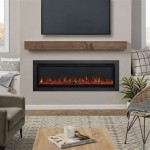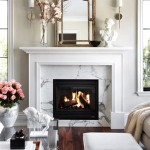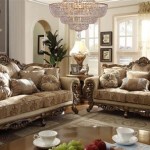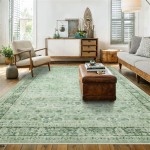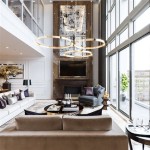Modern Interior Decorating Ideas for Living Room Design
The living room serves as a central gathering space within a home, often functioning as an area for relaxation, entertainment, and social interaction. As such, its design significantly impacts the overall ambiance and functionality of the living space. Modern interior decorating approaches for living rooms emphasize clean lines, functionality, and a balance of comfort and style. These design principles aim to create a welcoming and aesthetically pleasing environment that reflects the homeowner's personality and lifestyle.
Modern interior design encompasses a range of styles, but common threads include minimalism, natural elements, and a focus on creating visually appealing and comfortable spaces. Achieving a modern aesthetic requires careful consideration of various elements, including color palettes, furniture selection, lighting design, and the incorporation of decorative accessories. The goal is to create a cohesive and harmonious living room that is both stylish and functional.
Embracing Neutral Color Palettes with Accents of Color
A cornerstone of modern living room design is the utilization of neutral color palettes. Shades of white, gray, beige, and cream serve as a foundation, providing a versatile backdrop that allows furniture and accessories to stand out. These neutral tones create a sense of calm and spaciousness, making the room feel larger and more inviting.
While neutral palettes dominate, strategic use of accent colors is crucial to add visual interest and personality to the living room. Accent colors can be introduced through various elements, such as throw pillows, rugs, artwork, and decorative objects. Popular accent colors in modern design include shades of blue, green, yellow, and even muted pastels. The key is to choose accent colors that complement the neutral base and create a balanced and harmonious color scheme.
The application of color goes beyond simple choices; it involves understanding the psychological impact of different hues. Cooler colors, like blues and greens, tend to evoke feelings of tranquility and relaxation, making them ideal for creating a serene atmosphere. Warmer colors, such as yellows and oranges, can add a sense of energy and vibrancy. The selection of accent colors should align with the overall desired mood and aesthetic of the living room.
Moreover, consider the interplay of different textures within the color palette. For instance, incorporating a textured throw pillow in the same accent color as a piece of artwork can add depth and visual interest. Matte finishes on walls can provide a subtle contrast to glossy or metallic accents in furniture and decor, creating a more dynamic and sophisticated look.
Prioritizing Functional and Minimalist Furniture
Modern living room furniture prioritizes functionality and minimalist design principles. Furniture pieces should be chosen for their purpose and contribution to the overall aesthetic, avoiding unnecessary clutter and ornamentation. Clean lines, simple silhouettes, and high-quality materials are hallmarks of modern furniture design.
Sectional sofas are a popular choice for modern living rooms, offering ample seating and a comfortable lounging experience. Look for sectionals with streamlined designs and neutral upholstery colors. Modular furniture pieces, which can be rearranged to suit different needs, are also a practical and versatile option. Consider the scale of the furniture in relation to the size of the room. Overly large furniture can make a small living room feel cramped, while undersized furniture can get lost in a larger space.
Coffee tables are another essential element of the modern living room. Opt for coffee tables with clean lines and minimalist designs, such as those made of glass, metal, or wood. Consider the functionality of the coffee table as well. Some coffee tables offer storage solutions, such as drawers or shelves, which can help keep the living room organized. Side tables, consoles, and media units should also adhere to the same principles of functionality and minimalist design.
Upholstery choices play a critical role in the overall look and feel of the living room. Durable and easy-to-clean fabrics, such as linen, cotton, and microfiber, are practical options for sofas and chairs. Leather furniture can also add a touch of sophistication and luxury to a modern living room. The key is to choose upholstery materials that are both stylish and functional, capable of withstanding daily use and maintaining their appearance over time.
Integrating Natural Light and Strategic Lighting Fixtures
Natural light is a crucial element in modern living room design. Maximize the amount of natural light entering the room by keeping windows clear and unobstructed. Lightweight curtains or blinds can be used to filter sunlight and provide privacy, while still allowing ample light to penetrate the space. The arrangement of furniture should also be considered to ensure that natural light is distributed evenly throughout the room.
Artificial lighting plays a vital role in creating ambiance and functionality in the living room, especially during evening hours. A combination of ambient, task, and accent lighting is essential to achieve a well-lit and versatile space. Ambient lighting provides overall illumination, while task lighting is focused on specific areas, such as reading nooks or work spaces. Accent lighting is used to highlight architectural features or decorative objects.
Recessed lighting is a popular choice for ambient lighting in modern living rooms. It provides a clean and unobtrusive source of light that can be easily controlled with dimmers. Floor lamps and table lamps can also be used to supplement ambient lighting and add a touch of warmth to the room. Task lighting can be provided by adjustable floor lamps or desk lamps, allowing for focused illumination when needed.
Accent lighting can be achieved through the use of spotlights, track lighting, or decorative wall sconces. These fixtures can be used to highlight artwork, architectural details, or other decorative elements in the living room. The placement of lighting fixtures should be carefully considered to create a balanced and visually appealing lighting scheme.
Furthermore, the choice of light bulbs can significantly impact the overall ambiance of the living room. Warm white light bulbs (2700K-3000K) tend to create a cozy and inviting atmosphere, while cool white light bulbs (3500K-4100K) provide a more energizing and modern feel. LED light bulbs are an energy-efficient and long-lasting option for all types of lighting fixtures.
Incorporating Natural Elements and Biophilic Design
Biophilic design principles aim to connect interior spaces with the natural world, fostering a sense of well-being and connection to the environment. Incorporating natural elements into the living room can enhance the aesthetic appeal and create a more relaxing and inviting atmosphere. This involves integrating elements like plants, natural materials, and patterns that mimic nature.
Adding indoor plants is a simple and effective way to bring nature into the living room. Plants not only add visual interest but also improve air quality and create a sense of calm. A variety of plants can be used, from small potted succulents to larger floor plants. Consider the lighting conditions in the living room when choosing plants, as some plants thrive in bright light while others prefer shade.
Natural materials, such as wood, stone, and bamboo, can be incorporated into the living room through furniture, flooring, and decorative accents. Wood furniture adds warmth and texture, while stone accents can create a sense of grounding and stability. Bamboo flooring or wall coverings can add a touch of exotic flair to the space.
Natural patterns can also be incorporated into the living room through textiles, wallpaper, and artwork. Patterns that mimic natural forms, such as leaves, flowers, and geological formations, can add visual interest and create a sense of connection to the natural world. The use of natural materials and patterns can help create a more organic and harmonious living room design.
Additionally, consider incorporating water features, such as small fountains or aquariums, into the living room. The sound of flowing water can be incredibly calming and relaxing, creating a peaceful and serene atmosphere. These elements, when carefully integrated, contribute to a living room that feels restorative and connected to the natural environment.
Adding Personal Touches and Decorative Accessories
While modern design emphasizes minimalism and functionality, it's important to personalize the living room to reflect the homeowner's unique style and personality. Decorative accessories can be used to add visual interest, texture, and personal touches to the space. However, it's important to avoid clutter and maintain a sense of balance.
Artwork is a powerful tool for adding personality and visual interest to the living room. Choose artwork that reflects your personal taste and complements the overall design aesthetic. A large statement piece can serve as a focal point, while smaller pieces can be used to create a gallery wall. Consider the colors, textures, and subject matter of the artwork to ensure that it harmonizes with the rest of the room.
Throw pillows and blankets are another easy and affordable way to add color, texture, and comfort to the living room. Choose throw pillows in a variety of sizes, shapes, and fabrics to create a layered and visually appealing look. A cozy throw blanket draped over the sofa can add warmth and comfort, especially during cooler months.
Rugs can define different zones within the living room and add warmth and texture to the floor. Choose a rug that complements the color scheme and furniture style of the room. Consider the size of the rug in relation to the size of the room and the furniture layout. A rug that is too small can make the room feel disjointed, while a rug that is too large can overwhelm the space.
Personal collections, such as books, ceramics, or travel souvenirs, can be displayed in the living room to add personal touches and create conversation starters. Arrange these items in a visually appealing manner on shelves, coffee tables, or side tables. Be mindful of clutter and avoid overcrowding the space with too many decorative objects. The goal is to create a curated and personalized living room that reflects your unique style and interests.

10 Must Try Modern Living Room Design Ideas

30 Latest Living Room Designs With Pictures In 2025

10 Modern Living Room Ideas Oppein

100 Modern Living Room Design Ideas 2024 Home Interior Wall Decorating P8

Urban Living Room Decor Modern Contemporary Design Ideas

50 Style Modern Living Room Ideas To Try In 2024

Contemporary Living Room Design Timeless And Iconic

21 Most Wanted Contemporary Living Room Ideas

Stunning Modern Living Room Interior Design Ideas In

Modern Living Room Decor Ideas For The Perfect Makeover

